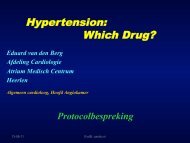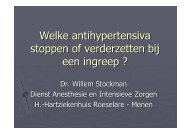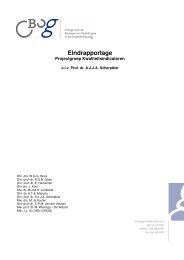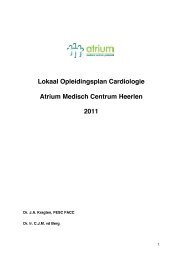Guidelines on the Management of Stable Angina Pectoris ... - Cardio
Guidelines on the Management of Stable Angina Pectoris ... - Cardio
Guidelines on the Management of Stable Angina Pectoris ... - Cardio
You also want an ePaper? Increase the reach of your titles
YUMPU automatically turns print PDFs into web optimized ePapers that Google loves.
ESC <str<strong>on</strong>g>Guidelines</str<strong>on</strong>g> 9Recommendati<strong>on</strong>s for resting ECG for initial diagnosticassessment <strong>of</strong> anginaClass I (in all patients)(1) Resting ECG while pain free (level <strong>of</strong> evidence C)(2) Resting ECG during episode <strong>of</strong> pain (if possible) (level <strong>of</strong>evidence B)Recommendati<strong>on</strong>s for resting ECG for routine reassessmentin patients with chr<strong>on</strong>ic stable anginaClass IIb(1) Routine periodic ECG in <strong>the</strong> absence <strong>of</strong> clinical change(level <strong>of</strong> evidence C)ECG stress testingExercise ECG is more sensitive and specific than <strong>the</strong> restingECG for detecting myocardial ischaemia 134,135 and forreas<strong>on</strong>s <strong>of</strong> availability and cost is <strong>the</strong> test <strong>of</strong> choice to identifyinducible ischaemia in <strong>the</strong> majority <strong>of</strong> patients withsuspected stable angina. There are numerous reportsand meta-analyses <strong>of</strong> <strong>the</strong> performance <strong>of</strong> exercise ECGfor <strong>the</strong> diagnosis <strong>of</strong> cor<strong>on</strong>ary disease. 136–139 Using exerciseST-depressi<strong>on</strong> ,0.1 mV or 1 mm to define a positive test,<strong>the</strong> reported sensitivity and specificity for <strong>the</strong> detecti<strong>on</strong> <strong>of</strong>significant cor<strong>on</strong>ary disease range between 23–100% (mean68%) and 17–100% (mean 77%), respectively. Excludingpatients with prior MI, <strong>the</strong> mean sensitivity was 67% andspecificity 72%, and restricting analysis to those studiesdesigned to avoid work-up bias, sensitivity was 50% and specificity90%. 140 The majority <strong>of</strong> reports are <strong>of</strong> studies where <strong>the</strong>populati<strong>on</strong> tested did not have significant ECG abnormalitiesat baseline and were not <strong>on</strong> antianginal <strong>the</strong>rapy or were withdrawnfrom antianginal <strong>the</strong>rapy for <strong>the</strong> purposes <strong>of</strong> <strong>the</strong> test.Exercise ECG testing is not <strong>of</strong> diagnostic value in <strong>the</strong> presence<strong>of</strong> LBBB, paced rhythm, and Wolff–Parkins<strong>on</strong>–White (WPW)syndrome, in which cases, <strong>the</strong> ECG changes cannot be evaluated.Additi<strong>on</strong>ally, false-positive results are more frequent inpatients with abnormal resting ECG in <strong>the</strong> presence <strong>of</strong> LVH,electrolyte imbalance, intraventricular c<strong>on</strong>ducti<strong>on</strong> abnormalities,and use <strong>of</strong> digitalis. Exercise ECG testing is also less sensitiveand specific in women. 141Interpretati<strong>on</strong> <strong>of</strong> exercise ECG findings requires a Bayesianapproach to diagnosis. This approach uses clinicians’pre-test estimates <strong>of</strong> disease al<strong>on</strong>g with <strong>the</strong> results <strong>of</strong> diagnostictests to generate individualized post-test diseaseprobabilities for a given patient. The pre-test probabilityis influenced by <strong>the</strong> prevalence <strong>of</strong> <strong>the</strong> disease in <strong>the</strong> populati<strong>on</strong>studied, as well as clinical features in an individual. 142Therefore, for <strong>the</strong> detecti<strong>on</strong> <strong>of</strong> cor<strong>on</strong>ary disease, <strong>the</strong>pre-test probability is influenced by age and gender andfur<strong>the</strong>r modified by <strong>the</strong> nature <strong>of</strong> symptoms at an individualpatient level before <strong>the</strong> results <strong>of</strong> exercise testing are usedto determine <strong>the</strong> posterior or post-test probability, asoutlined in Table 4.In populati<strong>on</strong>s with a low prevalence <strong>of</strong> ischaemic heartdisease <strong>the</strong> proporti<strong>on</strong> <strong>of</strong> false-positive tests will be highwhen compared with a populati<strong>on</strong> with a high pre test probability<strong>of</strong> disease. C<strong>on</strong>versely, in male patients with severeeffort angina, with clear ECG changes during pain, <strong>the</strong>pretest probability <strong>of</strong> significant cor<strong>on</strong>ary disease is high(.90%), and in such cases, <strong>the</strong> exercise test will not <strong>of</strong>feradditi<strong>on</strong>al informati<strong>on</strong> for <strong>the</strong> diagnosis, although it mayadd prognostic informati<strong>on</strong>.A fur<strong>the</strong>r factor that may influence <strong>the</strong> performance <strong>of</strong><strong>the</strong> exercise ECG as a diagnostic tool is <strong>the</strong> definiti<strong>on</strong> <strong>of</strong> apositive test. ECG changes associated with myocardialischaemia include horiz<strong>on</strong>tal or down-sloping ST-segmentdepressi<strong>on</strong> or elevati<strong>on</strong> [1 mm (0.1 mV) for 60–80 msafter <strong>the</strong> end <strong>of</strong> <strong>the</strong> QRS complex], especially when <strong>the</strong>sechanges are accompanied by chest pain suggestive <strong>of</strong>angina, occur at a low workload during <strong>the</strong> early stages <strong>of</strong>exercise and persist for more than 3 min after exercise.Increasing <strong>the</strong> threshold for a positive test, for example,to 2 mm (0.2 mV) ST-depressi<strong>on</strong>, will increase specificityat <strong>the</strong> expense <strong>of</strong> sensitivity. A fall in systolic pressure orlack <strong>of</strong> increase <strong>of</strong> blood pressure during exercise and <strong>the</strong>appearance <strong>of</strong> a systolic murmur <strong>of</strong> mitral regurgitati<strong>on</strong> orventricular arrhythmias during exercise reflect impaired LVfuncti<strong>on</strong> and increase <strong>the</strong> probability <strong>of</strong> severe myocardialischaemia and severe CAD. In assessing <strong>the</strong> significance <strong>of</strong><strong>the</strong> test, not <strong>on</strong>ly <strong>the</strong> ECG changes but also <strong>the</strong> workload,heart rate increase and blood pressure resp<strong>on</strong>se, heartrate recovery after exercise, and <strong>the</strong> clinical c<strong>on</strong>textshould be c<strong>on</strong>sidered. 143 It has been suggested that evaluatingST changes in relati<strong>on</strong> to heart rate improves reliability<strong>of</strong> diagnosis 144 but this may not be so in symptomaticpopulati<strong>on</strong>s. 145–147An exercise test should be carried out <strong>on</strong>ly after carefulclinical evaluati<strong>on</strong> <strong>of</strong> symptoms and a physical examinati<strong>on</strong>including resting ECG. 135,140 Complicati<strong>on</strong>s during exercisetesting are few but severe arrhythmias and even suddendeath can occur. Death and MI occur at a rate <strong>of</strong> less thanor equal to <strong>on</strong>e per 2500 tests. 148 Accordingly, exercisetesting should <strong>on</strong>ly be performed under careful m<strong>on</strong>itoringin <strong>the</strong> appropriate setting. A physician should be presentor immediately available to m<strong>on</strong>itor <strong>the</strong> test. The ECGshould be c<strong>on</strong>tinuously recorded with a printout at preselectedintervals, mostly at each minute during exercise,and 2–10 min <strong>of</strong> recovery after exercise. Exercise ECGshould not be carried out routinely in patients with knownsevere aortic stenosis or hypertrophic cardiomyopathy,although carefully supervised exercise testing may be usedto assess functi<strong>on</strong>al capacity in selected individuals with<strong>the</strong>se c<strong>on</strong>diti<strong>on</strong>s.Ei<strong>the</strong>r <strong>the</strong> Bruce protocol or <strong>on</strong>e <strong>of</strong> its modificati<strong>on</strong>s <strong>on</strong> atreadmill or a bicycle ergometer can be employed. Mostc<strong>on</strong>sist <strong>of</strong> several stages <strong>of</strong> exercise, increasing in intensity,ei<strong>the</strong>r speed, slope, or resistance or a combinati<strong>on</strong> <strong>of</strong> <strong>the</strong>sefactors, at fixed intervals, to test functi<strong>on</strong>al capacity. It isc<strong>on</strong>venient to express oxygen uptake in multiples <strong>of</strong>resting requirements. One metabolic equivalent (MET) is aunit <strong>of</strong> sitting/resting oxygen uptake [3.5 mL <strong>of</strong> O 2 per kilogram<strong>of</strong> body weight per minute (mL/kg/min)]. 149 Bicycleworkload is frequently described in terms <strong>of</strong> watts (W).Increments are <strong>of</strong> 20 W per 1 min stage starting from 20 to50 W, but increments may be reduced to 10 W per stage inpatients with heart failure or severe angina. Correlati<strong>on</strong>between METs achieved and workload in watts varies withnumerous patient-specific and envir<strong>on</strong>mental factors. 135,150The reas<strong>on</strong> for stopping <strong>the</strong> test and <strong>the</strong> symptoms at thattime, including <strong>the</strong>ir severity, should be recorded. Time to<strong>the</strong> <strong>on</strong>set <strong>of</strong> ECG changes and/or symptoms, <strong>the</strong> overallexercise time, <strong>the</strong> blood pressure and heart rate resp<strong>on</strong>se,<strong>the</strong> extent and severity <strong>of</strong> ECG changes, and <strong>the</strong> postexerciserecovery rate <strong>of</strong> ECG changes and heart rateshould also be assessed. For repeated exercise tests, <strong>the</strong>














